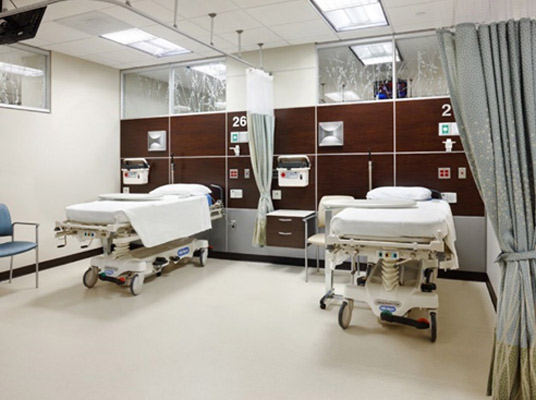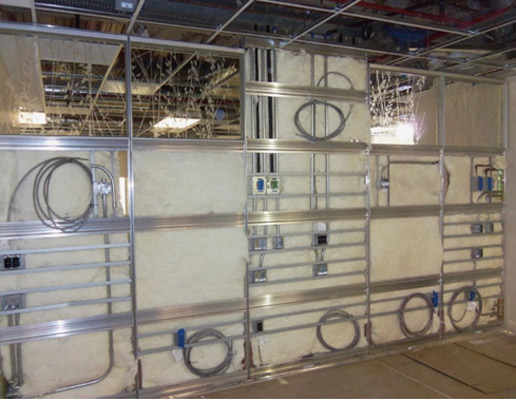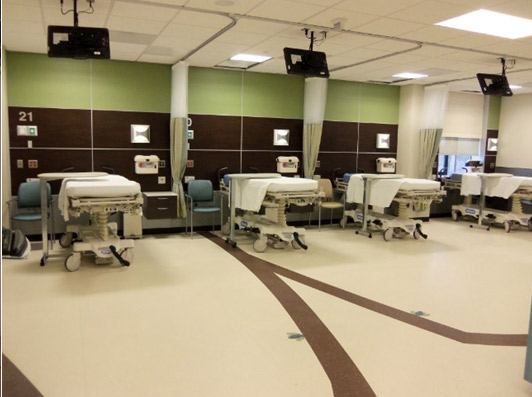Achieving Greater Design Control through Off-site Custom Fabrication
Evolving processes allow design and construction to be integrated to create better and smarter buildings
![]() Continuing Education
Continuing Education
Use the following learning objectives to focus your study while reading this month’s Continuing Education article.
Learning Objectives - After reading this article, you will be able to:
- Compare and contrast traditional sequential design and construction processes with multiple, concurrent, pre-fabrication construction processes.
- Identify and recognize the emerging trends of integrated project delivery, prefabrication, and modularization that are evident in building design and construction.
- Assess the functional contributions of custom fabricated interior walls as they contribute to green and sustainable design
- Investigate the innovative design opportunities to create buildings that are flexible in use and sustainable by nature using custom fabricated interior walls.
The process of design and construction is evolving. There are observable and well-documented trends in integrated project delivery, building information modeling, “lean” design, and pre-fabricated construction. In light of these trends, traditional methods for creating buildings are being recognized as obsolete when compared to creating other things such as airplanes, automobiles, or even computers. In an evolving world, changing the way we think about the construction process gives us an opportunity to gain greater control over the design of the total building by understanding how components and systems can be created better, quicker, and more economically. Architects who are able to embrace the emerging changes can use them to benefit their projects, their clients, and their firms.
Traditional Sequential Design and Construction
Most of us are very familiar with the current traditional sequence of design and construction. Separate contracts are drawn up first between the building owner and the architect for design and then between the owner and the contractor for construction. Sub-contracts are similarly drawn up as needed for design consultants and construction trades respectively, solidifying a rather common and legally preferred separation of multiple roles and responsibilities. While some “design-build” firms certainly exist in certain states where licensing laws allow it, the very old role of a “Master Builder” who did both design and construction, coordinating all aspects of a project from start to finish, is not common. Risk-adverse insurance companies and the practical limitations of overseeing buildings that are increasingly more complex in terms of materials, systems, and function will likely continue to require that commercial buildings use multiple entities to accomplish successful design and construction.
The process of construction itself is similarly rooted in a sequence of separate roles and responsibilities between managers, trades, product suppliers, and equipment renters. The current default mindset is that all of these people, materials, and equipment will show up to a particular construction site at their appointed time to create a building by making it entirely on site. Certainly some things can only be done on site such as earthwork and maybe some aspects of foundation work. But it is also commonly assumed that the structural framing, skin enclosure, interior systems, finishes, and user equipment will all arrive in commonly available specified pieces that are to be assembled or installed in the field.
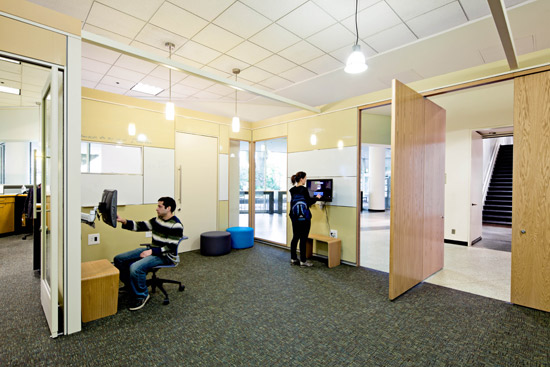
Photo courtesy of DIRTT Environmental Solutions
Building design and construction is evolving and advancing to embrace innovative custom fabrication principles similar to those used in other industries.
The notable and common challenges with this separated and fragmented process include work coordination and quality control. Scheduling and coordinating each aspect of the work is usually fairly straightforward at the macro level. However, it can present significant challenges at the detail level if one material or labor issue arises that disrupts the overall sequence, impacts others, and delays the entire project. Such delays mean more administrative time and usually more cost as a result that is either borne by the contractor or passed onto the owner. Similarly, scheduling different people, materials, and processes also impacts the quality of the construction as well. If proper provisions aren’t made ahead of time for weather or environmental conditions, then materials may not end up with the intended properties or characteristics. If multiple trades all converge on a small area (bathrooms for example), then the number of workers in the space and their sequence becomes an important factor in the quality of the finished work. Similarly, when multiple materials from different manufacturers are being assembled on site by different people, fit and finish particularly along the “joints” where they meet becomes a defining element of the final construction quality.
Emerging Integrated, Contemporary, Construction
Those of us involved in building design and construction have likely recognized the need to find ways that can improve on the current traditional processes. In recent years, many building owners have actually come to demand it since they have had to live with the consequences of scheduling delays, lack of proper coordination, compromised quality, or long-term maintenance headaches. There have been several responses to this industry-wide need that merit some attention here.
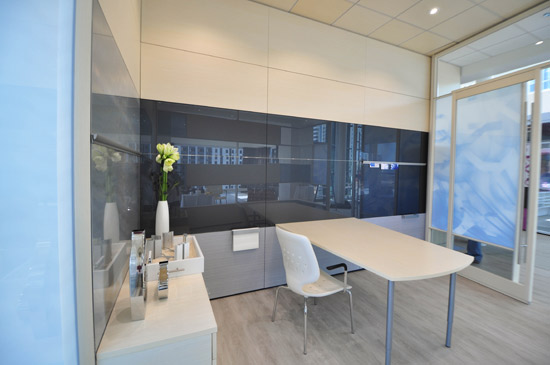
Photo courtesy of DIRTT Environmental Solutions
The ultimate project delivery outcome of any project can be enhanced and improved through greater collaboration between designers, constructors, fabricators, and installers.
Integrated Project Delivery
The American Institute of Architects (AIA) has developed a long-standing position on “project delivery” which is fundamentally the process by which a project successfully moves through all aspects of design and construction. Specifically, the member approved Position Statement #26 states, “The AIA believes that project delivery processes must enhance the quality, cost-effectiveness, and sustainability of our built environment. This can best be achieved through industry-wide adoption of approaches to project delivery characterized by early and regular involvement of owners, architects, constructors, fabricators, and end user/operators in an environment of effective collaboration, mutually defined goals and open information sharing. The AIA also believes that the architect is most qualified to lead the design of a project and can lead a project team throughout the project delivery process.” (emphasis added) This statement reflects the need to cross over traditional separated roles and responsibilities and focus on collaboration and sharing of information in the best interest of better project outcomes. The rationale for it is based on a clear recognition for the need to move toward a collaborative delivery processes that delivers benefits to all stakeholders. The expectation is that owners can see the value of design in positively transforming their business or mission. Similarly, constructors that collaborate early with owners and architects can focus on enhanced construction techniques resulting in improved project quality and financial performance. Architects can realize more potential time for design exploration, reduced time in preparing documentation, improved cost control, and better budget management. In short, a collaborative, integrated process has the potential of offering better design, better construction quality, and better financial results for all involved compared to traditional sequential, separated processes. It has also been recognized as a key ingredient in creating more energy-efficient and sustainable buildings.
Modular and Prefabricated Design and Construction
There has been a good amount of independent work done on researching the trend toward modular or prefabricated construction that began to emerge following World War II. In the book “Prefab Architecture: A Guide to Modular Design and Construction” (John Wiley & Sons, Inc. 2010) author Ryan E. Smith chronicles first the history of industrialized building and architecture in the context of environment, organization, and technology. Here he identifies 20th century examples of work and trends that have contributed to current notions of manufactured construction.
In light of this context, the book moves on to delve into the application of principles and fundamental organizing elements of creating a pre-fabricated or modular building or its significant parts. He includes a look at components, panels, modules, and even the popular fascination with ISBU shipping containers as a manufactured enclosure. Since the ultimate process is all about assembly, he discusses strategies, detailing, tolerances, and sequencing of the assembly work. Transporting the prefabricated product to the site is addressed along with final installation. He recognizes this total process as one that is inherently more sustainable, although it does have its own challenges to reach that status. The book moves beyond the theoretical to the practical and provides a number of case studies using prefabricated and modular construction in both residential and commercial applications. Part of the conclusions include the recognition that fully assembled three-dimensional modules are not always the most cost effective, as in the case of common “double wide” manufactured housing due to transportation issues. Rather, panelized components that are more easily shipped but have been assembled and tested first in the factory are preferable in many cases.

Photos © John Wiley and Sons and McGraw Hill Construction
Some significant publications have documented thee history, innovations, and market trends related to the shift away from purely site built construction and toward greater use of pre-manufactured, custom construction.
Mass Customization
A separate landmark study and resultant book titled “refabricating ARCHITECTURE” (McGraw Hill 2004) carried out and authored by award-winning architects and professors Stephen Kieran and James Timberlake was funded in part by the distinguished AIA College of Fellows Latrobe Prize. The premise of their work is that architecture and construction processes are lagging behind the times compared to other industries in terms of the way things are designed and built.
Beginning with a look at the classical approach that produced “Master Builders” in the Renaissance, they delve into the modern approach focused on separating out roles and responsibilities so there is no longer any such “Master Builder.” In essence, they cite the fact that architects have lost control of the design since contemporary complex buildings require more information and expertise on the many and varied components than any one architect could ever hope to master. The splintering of roles further erodes the architect’s ability to maintain design control. By contrast, the authors cite material scientists and product engineers involved in the automobile making, ship-building, and airline manufacturing industries who have all elevated their status and gained greater design control in recent times. This has come about by the convergence of several evolutionary activities. Foremost, design and construction in these other industries are typically fully integrated. That means that everyone is at the table from the earliest stage of conception through the ongoing production of the final version.
Beyond the people aspect, however, they cite an even larger phenomenon that crosses all of these industries. Simply put, manufacturing of automobiles, airplanes, or ships is no longer about using an assembly line of individual parts to create a finished product. Instead, manufacturing has become a process of joining discreet and well-defined subassemblies into the larger finished product. These subassemblies may be a group of pre-assembled components, fully crafted modules, or basic sectional blocks that are all produced off-site, often simultaneously, then sent to a main plant for final assembly. Examples in an automobile might be a fully crafted chassis assembly, a completely wired and assembled dashboard, or complete seats in the cabin. There are several benefits to this process that their research has revealed. First, the design of each subassembly can be looked at in its entirety and optimized for better design and quality control. It is not uncommon to find ways to integrate materials and pieces such that a component or subassembly actually has fewer parts and pieces than its predecessor did on an assembly line scenario. Second, since the whole subassembly is done together, there are opportunities for saving time and money by gaining efficiencies that may not have existed before. This is especially true when skilled workers are used in each subassembly who have the opportunity to focus on perfecting the means to create the subassembly to exacting standards required by the overall product. Working on smaller sections means that they can more readily be worked on from different sides in ways that are more ergonomic for workers and without the need for hoisting equipment.
Perhaps the greatest benefit from this evolved process is greater customization. Linking the assembly and subassembly process together with computerized methods for communicating, means that each subassembly can be fabricated to order. Anyone who has ever ordered a computer from companies like Dell or similar has experienced what Kieran and Timberlake call “mass customization.” Dell doesn’t “mass produce” computers, rather they have determined a collection of components and subassemblies that can be assembled to order to meet the custom requirements of the purchaser. Need more memory, then choose how much. Want better graphics, they offer options. You get the idea— it isn’t about individual products as much as it is about individualized orders.
The significance of all of these manufacturing trends is that the architecture profession and construction industries can learn from these mass customization successes and adopt similar tactics to create custom fabricated components and even entire buildings. By using specialized fabricators that can focus on particular subassemblies, quality of construction and tolerances can improve. Further, multiple components traditionally handled by separate trades can be integrated into the single source subassembly, improving the fit and coordination while also saving time and expense in the field. Using computer software, the building assemblies can be fully customized to meet design requirements and specifications. Since the cost of transportation has become less expensive than the cost of many individual products or parts it has actually been shown to be quite cost-effective to fabricate many construction assemblies off-site and have them shipped to the building site for installation. In so doing, the issues of weather protection and product storage are diminished or even eliminated by fabricating in a controlled indoor environment and scheduling delivery to coincide directly with construction schedules.
Kieran and Timberlake also offer specific examples from their own work that put these principles into practice. These include fully custom-fabricated portions of buildings such as pre-hung commercial doors with frames, all hardware, and glazing; modular exterior wall sections; and bathroom millwork vanities as part of a wall system.
Current Market Report
McGraw Hill Construction regularly conducts market research on timely topics and often publishes the results in Smart Market Reports. A 2011 study titled Prefabrication and Modularization (http://mcgrawimages.buildingmedia.com/market_research/FreeReport/PrefabSMR/) shows an observable increase in productivity in the construction industry due to the growing use of prefabrication and modularization of building construction. It is significant that off-site fabrication is recognized as a strong trend and warranted the study in the first place.
Some of the findings of the study include a determination that among those surveyed and engaged in using pre-fabricated or modular construction:
• 66% report that project schedules are decreased—35% by four weeks or more.
• 65% report that project budgets are decreased—41% by 6% or more.
• 77% report that construction site waste is decreased—44% by 5% or more.
In short those already involved in incorporating this type of thinking into their work are finding significant savings in time and money while also reducing construction waste.
The research also revealed that prefabrication and modular construction is currently in use in a wide variety of building types with highest opportunity in healthcare facilities, hotel/hospitality, high-rise office, commercial warehouses, manufacturing, multifamily, and K-12 schools among others. The types of common prefabrication or modularization used are found in exterior walls, mechanical/electrical/plumbing (MEP) building systems, building superstructure, roof construction, floor construction, and interior room modules. These research findings demonstrate the growing use of this approach in buildings and have implications and benefits for different building project stakeholders including owners, architects, engineers, general contractors/construction managers, specialty contractors, and manufacturers.
Custom Fabricated Interior Partition Walls
In order to illustrate in more detail how the principles and concepts discussed thus far could play into an overall building project, we will use an example subassembly. Specifically, let’s consider the use of off-site custom fabrication for interior partition walls (i.e. non load bearing interior walls).
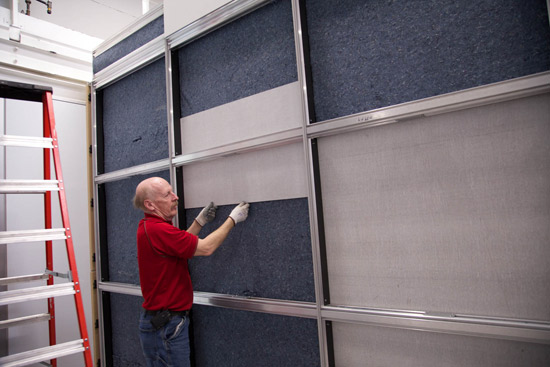
Photo courtesy of DIRTT Environmental Solutions
Interior partition walls can be constructed using traditional site built methods or in a controlled environment as part of a custom fabrication process shown here.
Traditional Interior Walls
The traditional method of creating interior walls in commercial construction involves the use of metal or wood framing that is covered with gypsum board. The framing is delivered in mass produced standard sizes, cut to suit the building requirements, and assembled in place “from scratch” in the field. Then, different MEP trades come to install electrical, plumbing, or communication wiring, boxes, components, etc. in the framing cavities. Once inspected, the cavities are covered and finished with drywall which involves considerable time for drying between coats of finishing compound not to mention the ubiquitous dust from sanding. The surface is then painted or otherwise finished by a different trade followed by a return by the MEP crews to add the final connections and finish elements to their systems. Base and/or ceiling trim is added as appropriate in coordination with the floor and ceiling systems and the design details of the building. In a perfect world, there would be no “punch list” when all of this is complete, but more likely than not, there will be gypsum board repairs, paint touch up, and perhaps MEP adjustments that need to be made. Overall, the process takes multiple weeks using multiple trades with multiple opportunities for loss of quality control. Further, if an interior partition needed to be relocated during the life of the building, it would have to be removed and the process begun, and paid for, all over again.
Modular and Prefabricated Walls
Recognizing the limitations of traditional interior partitions walls, movable interior office partitions were developed as one of the first, commonly available, pre-fabricated alternatives. This system of free-standing partitions were equated to being part of a furniture system that allowed for standard sizes, finishes, and options. Time schedule savings coupled with long-term value were generally seen to offset their higher initial cost. From an owner’s perspective, they were a tangible asset that could be moved and re-configured either within a building or even between buildings just as any other furniture. Because of this greater flexibility and potentially longer life span, they were regarded as more sustainable over the long term. While these are all good and desirable traits, such movable partitions typically applied only to office situations and didn’t necessarily meet the needs of other building types.
Custom Fabricated Interior Walls
The next logical step in the evolution of interior walls has now become readily available in the U.S. and Canada. Companies are emerging that are fulfilling the vision of off-site custom fabricated interior walls and contributing all of the anticipated benefits to the design and construction process. The fabrication approach is less about a modular wall system and more about a custom, adaptive approach to rapid and sustainable construction. In the truest sense of mass customization, there are no standard sizes, only standard components that can be used to build interior walls to order based upon the architect’s design and specifications. The components can be categorized into different configurable layers. The base is a structural or framing layer that gives the wall its rigidity and form. A technological layer within the structural cavities is possible that can include pre-wired and pre-configured MEP systems but that is also fully coordinated with the rest of the wall assembly. Through the use of common “plug and play” type of connectors, pre-wired electrical, communication, and computer, systems can readily connect to the larger building system in a quick, convenient manner. Next, an aesthetic or finish layer can be specified from a variety of choices and appearances, most of which avoid the time requirements of gypsum board. The final layer is often regarded as the application-specific elements which address the interface of the interior walls with the other building systems specifically along the ceiling and floor. It could also include pre-configured and pre-installed doors of various types. In certain situations, there may also be requirements for special needs in walls such as medical systems in healthcare environments or audio-visual requirements in educational settings. All of these can be accommodated by working collaboratively with the custom fabrication company to integrate and incorporate such needed systems.
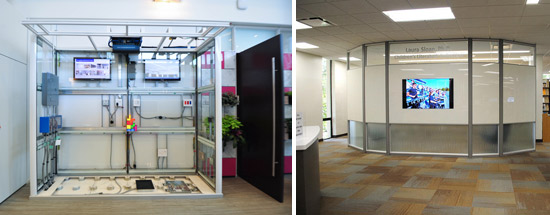
Photo courtesy of DIRTT Environmental Solutions
Custom fabricated partition walls can include all needed mechanical, electrical, plumbing, and computer data lines installed and coordinated in advance.
It is through this multi-layered approach that custom fabricated interior wall companies can support faster fabrication (i.e. shorter time schedules), simply because multiple processes and activities can be done in parallel. Treating each layer as a subassembly of the wall and further treating the walls as a subassembly of a building means that the specified components feed into a larger, more efficient system in a very timely manner. There are essentially no practical boundaries to this approach; the solution provides adaptability, speed of installation, material efficiency, lower overall cost, and sustainability.
Coordinating Other Components
All interior walls provide an opportunity for a variety of other things to interface with them. Signage and graphics are one common example that can be incorporated during fabrication as part of the finished wall surface. In this age of digital information, it is also possible to incorporate a computer monitor directly into the wall assembly to convey information, graphics, video, or television stations. For spaces that require cabinetry for storage, it is possible to have those fabricated along with the interior walls such that they are pre-assembled and may be even pre-installed on the interior walls. In all of these cases, the important benefit is the full coordination of the design of these components with the wall design so that they are fully integrated with the walls as well as the overall design intent for the building.
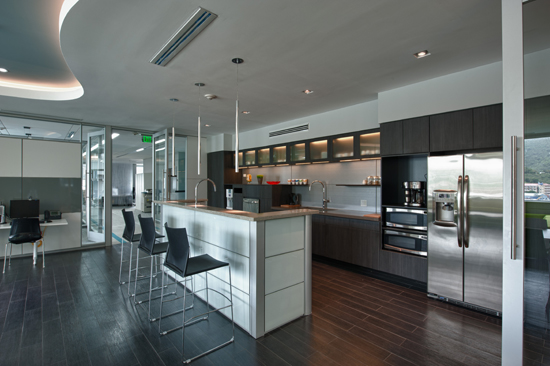
Photo courtesy of DIRTT Environmental Solutions
Building components such as cabinetry and millwork that need to coordinate with interior walls can be fabricated concurrently to assure full design control and proper integration.
A similar coordination opportunity is possible with other construction systems. All finish trim and millwork for example can be selected and incorporated as part of the custom fabrication. Doors of various types and sizes can be worked in wherever needed. Wiring and outlets for data and power can be integrated such that outlets are visible or concealed as appropriate to the rest of the design. In some cases raised, accessible, custom fabricated floors may also be specified to place and locate the interior walls on. In this manner, power, data, and other MEP items can be fully coordinated and controlled as part of the initial design but they can also allow the ready ability for maintenance and adjustments over time.
Design and Fabrication by Computer
One of the important elements of the success of this process is the use of computer software that directly links design and fabrication. A three-dimensional Building Information Modeling (BIM) style process allows for complete visualization and customization of all individual components as well as the fully custom fabricated walls. Design options can be quickly and easily seen in 3D by designers and clients alike with direct links to show real-time cost and scheduling impacts of different choices. In this manner, the design file is actually the shop drawing or construction file that controls all aspects of the fabrication. As such, the whole process produces a true, fabricated, “what you see is what you get” interior wall that is shipped to the building site and integrates directly with the rest of the building as designed.
This collaborative computer software based design process offers a number of other significant advantages. First it allows designers to make final selections right up to the last possible, responsible moment in the overall construction process. Second it allows the latest mechanical, electrical, plumbing, or computer network systems to be included rather than specifying something many months in advance that have become obsolete. Third, it determines the full and final system makeup and cost. That means there is not only time savings in not needing to review shop drawings, there is also finalization of cost without the need to anticipate change orders or contingency expenses.
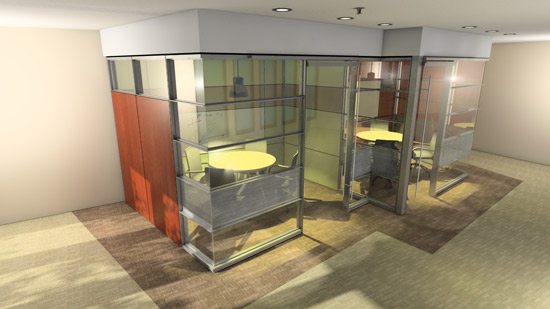
Photo courtesy of DIRTT Environmental Solutions
Three-dimensional computer simulation that includes real time cost and scheduling data allows for fully informed decision making when comparing different design and fabrication options.
As described above, the overall process of the custom fabricated solution allows architects to have direct input and control over the end result while creating completely new and unique assembly configurations. The process allows full and complete freedom of design across aesthetic, functional, and technological boundaries while effectively addressing integration and quality across all. Fundamentally, it provides solutions that can reflect the needs of the client in every way, as strongly at the time of original installation as through the passage of time. Since the walls are complete, coherent assemblies, they can be removed and re-installed to suit changing needs or re-configured and repurposed to accommodate changes in ownership.
Green Building Contributions of Custom Fabricated Interior Walls
The U.S. Green Building Council (USGBC) has developed the well-known LEED® rating system. The LEED 2009 system is in place until the year 2015 which overlaps with LEED version 4 introduced late in 2013. Buildings can currently be designed under either system and credits are available through the use of custom fabricated interior walls that can contribute to an overall green and sustainable building design.
Materials and Resources
This area has changed dramatically between the different versions of the LEED® rating system. LEED 2009 includes four areas where custom fabricated interior walls can contribute to an overall green building:
• Recycled Content: Some of the materials selected for the makeup of the walls can readily specified with recycled content. Steel framing for example could be almost fully recycled material while other materials may be partial recycled content.
• Regional Materials: There are a variety of locations across North America where custom fabricated interior walls are made with locally sourced materials. This means a regional material contribution is possible depending on proximity to the building site.
• Material Choices: It is entirely possible to specify and use materials that are rapidly renewable or made from certified wood where appropriate.
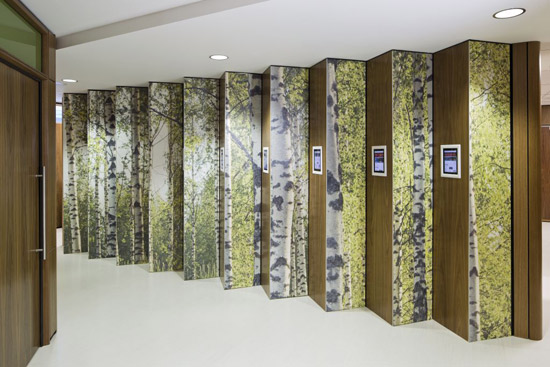
Photo courtesy of DIRTT Environmental Solutions
Custom fabricated interior partition walls can contribute to green and sustainable design through sustainable material selection and their inherently better life cycle impacts.
The Materials and Resources category under LEED v. 4 takes a rather different approach to defining the green nature of building products. There are still credits for Building Re-use and Construction Waste Management, but the rest of the approach focuses on the full life cycle of those products. The key documentation needed to demonstrate performance under this approach is based on a Life Cycle Assessment. The materials used can be identified in an Environmental Product Declaration (EPD). But the bigger advantage is in the ability of custom fabricated systems to be re-purposed and re-used during the life of the building, thus improving the overall life cycle impacts of the wall and related systems. In order to ensure flexibility and positive outcomes, at least three of the four following items must be undertaken:
• Install accessible floor or ceiling systems for at least 50% of project floor area.
• Design at least 50% of interior non-structural walls, ceilings, and floors to be movable or demountable.
• Ensure at least 50% of non-structural materials by cost are reusable or recyclable.
• Implement flexible power distribution (i.e. plug and play systems) for at least 50% of the floor area to facilitate reconfiguration and repurposing of the space.
Indoor Environmental Quality
Interior walls can have a direct impact on indoor environmental quality in several ways. First, by using glass and glazing in appropriate amounts and locations, natural daylight and views can be incorporated into the overall design of interior spaces. Beyond light, sound control is an increasingly recognized attribute of healthy indoor spaces and can be addressed by incorporating sound insulation and edge treatments in the makeup of a custom fabricated wall system. It is also much easier to control overall sound performance by controlling or eliminating unnecessary penetrations or sound breaches such as back-to-back electrical outlets. Directly related to indoor health is the impact of air quality in indoor spaces due to the materials selected for use in buildings. The selection of those materials is readily addressed in the off-site custom fabrication process. Low or no VOC materials can be selected and incorporated during fabrication. At the building site, the use of on-site paints, coatings, adhesives, or sealants can then be reduced or even eliminated.
Designing Buildings With Offsite Custom Fabricated Interior Walls
In order to further illustrate how offsite custom fabricated interior walls can be incorporated into a building, let’s look at using them in a healthcare facility. These types of buildings are among the most technologically intensive, fastest changing spaces that many architects deal with. Not only do they need to provide many different functional requirements, architectural designs also seek to provide an empathetic human experience for patients, visitors, and staff. Ultimately, overall success comes down to better care and improved patient outcomes.
Custom fabricated interior walls can satisfy all these criteria. They offer customized, accessible support for medical gasses, equipment, plumbing, power/data, handrails, furniture, storage, and audio/visual systems. Layout consistency is achievable through the ability to design the same placement of equipment in every room, making fewer opportunities for mistakes. For patients, the walls can incorporate the little things that make a medical stay more comfortable—like iPod docking stations, USB ports, artwork, and accessories for a neat display of cards and photos.
It is important to recognize that we are not necessarily talking only about new construction. Since the interior walls are completely customizable, they can be fabricated to suit the needs of existing building renovations or even conversions as readily as for new construction. This trait is true for all building types, but particularly relevant in healthcare settings where buildings have been in use for some time and are regularly upgraded, renovated, changed to meet new uses, or otherwise modified. Walls can be custom fabricated to fit around existing columns, bulkheads, beams, sills, or whatever else may already be in the building.
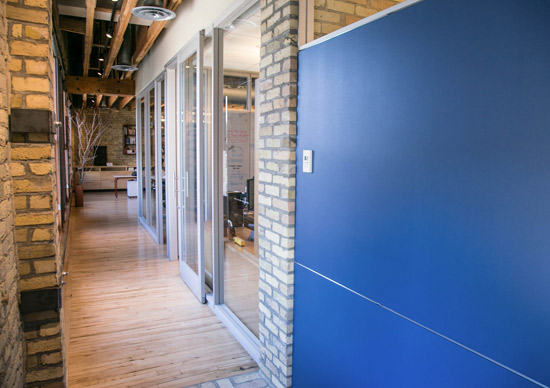
Photo courtesy of DIRTT Environmental Solutions
Existing building renovations are an ideal candidate for the use of custom fabrication since all existing conditions and features can be accounted for and accommodated in the overall fabrication scheme.
Incorporating custom fabricated interior walls into a healthcare project starts with the collaborative decision of the architect, owner, and contractor to do so. Collectively, all of the relevant project criteria that affect the interior spaces should be identified and used as the design basis for the wall fabrication. As in all normal design processes, the architect then lays out the spaces and identifies the specific interior wall locations and sizes.
At this point, collaborating with a custom fabrication company is very time efficient since all of the design particulars of the walls can be worked out and priced in a very collaborative manner. By looking at each of the “layers” or subassemblies of the interior walls, the range of options can be identified and the most appropriate choices can be made. Since the owner may well want to include healthcare staff and administrators in the process, using 3D visualization software to convey design intent and options can be extremely useful. When that is linked to cost and timing information, then fully informed, collaborative decisions can be made. This begins by selecting and specifying the framing system for the wall and considering the range of support requirements that may be needed. Healthcare facilities commonly require a wide variety of MEP systems that go beyond basic mechanical, electrical, and plumbing lines and can include dedicated water, medical gases, data, task lighting, or other technological connections. Each of these can be identified for each wall and planned out in the custom fabricated wall assembly accordingly. Since all of them are being looked at and fabricated at once, the final locations of the visible ports, plugs, etc. can all be coordinated and organized into the most functional and aesthetic layout. If acoustical control is required, then appropriate insulation and detailing can be incorporated as well.
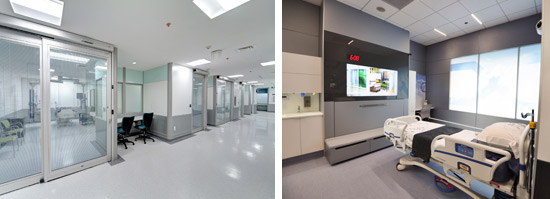
Photo courtesy of DIRTT Environmental Solutions
Healthcare settings are an ideal example of buildings that can realize all of the short- and long-term benefits of custom fabricated interior construction.
The finished surface of custom fabricated walls no longer needs to be limited to conventional field installed products. Rather, materials that address cleaning and sanitation, wall protection, and aesthetic design criteria can be selected from a variety of durable, fully finished options. Some of these options can include materials normally associated with other aspects of buildings like medium density overlay (MDO) board or similar high-density, easy-to-maintain products. Appearances can range from a simple uniform color, to wood grain, to geometric patterns, or others. In locations where the walls are needed more as a divider than as a carrier of other things, then glass and glazing can be incorporated to suit a particular design and allow light to flow between interior spaces. In all cases, the connection and interface with the rest of the building and the surrounding spaces can be incorporated and worked into the final customization so the installation in the building is fully integrated.
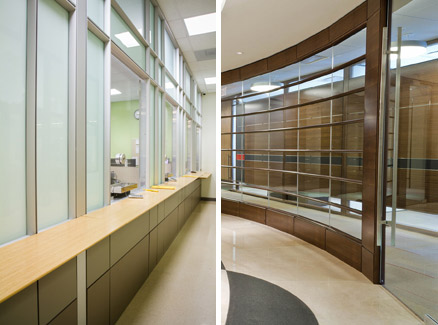
Photo courtesy of DIRTT Environmental Solutions
Interior finishes, shapes, configurations, and features can all be custom designed and fabricated to suit particular design requirements.
From an owner’s standpoint, using a building with this type of system has several benefits. Cleaning and maintenance may be the same or potentially easier than traditional site-built walls. Since all of the concealed systems were identified by the same source, the drawings or computer documentation of the details and locations means any adjustments down the road don’t need to rely on guesswork. If walls need to be relocated, they can be removed as individual units with all of the systems and attachments in place and fully re-usable. Just as important, ready access to maintain or replace MEP systems in the walls over the use of the facility is important and helpful. In all, the facility becomes easier to manage, maintain, and modify providing greater value and sustainability over time.
Conclusion
The traditional methods of design and construction are becoming obsolete and are starting to be replaced by more efficient, more practical, and more collaborative approaches. The trends in pre-manufactured building components are giving way to full off-site custom fabrication processes that are being recognized for their great value and improvements in design control. Architects, owners, contractors, and others who embrace this shift in doing business can realize better design outcomes, better quality of construction, shorter overall project schedules, increased sustainability, and long-term client satisfaction.
 |
DIRTT Environmental Solutions (Doing It Right This Time) creates award-winning custom prefab interiors for industries including corporate, government, education and healthcare. DIRTT’s innovative approach results in faster, cleaner construction with the highest levels of customization and flexibility; while significantly lowering a building's carbon footprint. DIRTT has manufacturing facilities in Phoenix, Savannah, Kelowna and Calgary. Our teams work with more than 100 Distribution Partners throughout North America, the Middle East and Asia. For more information please visit www.dirtt.net |

